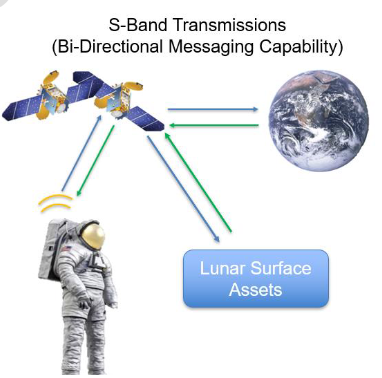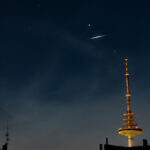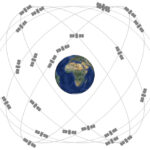A sophisticated satellite-based system allows pinpointing a person’s location in a dangerous, isolated situation on land or sea. It thus hopefully speeds their subsequent rescue in many cases.
This final part looks at the next generation of system satellites and some ideas for a similar lunar system.
The MEOSAR satellites
The most recent enhancement to Cospas-Sarsat is the MEOSAR constellation which provides many of the features of the LEOSAR and GEOSAR systems while minimizing the drawbacks. The plan is to have more than 70 MEOSAR satellites so that the MEOSAR system will become the dominant space-segment capability of Cospas-Sarsat.
The MEOSAR system offer benefits in addition to a large number of satellites. The relatively large footprint of each satellite and the large amount of satellite motion relative to a point on the ground allow the use of Doppler measurements as part of the method of calculating a distress beacon’s location.
In addition, the MEOSAR system will be able to provide near-instantaneous detection, identification, and location-determination of 406-MHz beacons. Multiple MEOSAR satellites may be in view of a given beacon’s signal. That overlap in coverage areas is an important factor in improving Doppler-based algorithm accuracy and location precision.
But what about the moon?
While an Earth-focused search-and-rescue system may seem like the end of the story, it is not. In fact, there’s a critical need for such a system for lunar exploration as envisioned by the Artemis lunar-landing and exploration program.
This may seem unnecessary, but it is not, as navigation on the moon is actually very difficult. Using a compass or a lunar equivalent to GNSS is obviously impossible. Yet our moon is a relatively featureless, landmark-free environment, with harsh shadows which shift dramatically with the sun’s motion and can mislead any personal sense of direction or distance. The relatively small size of the moon means that the distance to the horizon is short, and it is easy to lose sight of a starting point or base.
In fact, when the lunar rovers for the Apollo mission were designed, a large part of the effort was figuring out how to build a simple, lightweight, reliable, accurate odometer and navigation aid to allow them and the rover to go beyond just a short distance from the lander module base. That effort is detailed in the recently published and fascinating book “Across the Airless Wilds: The Lunar Rover and the Triumph of the Final Moon Landings” by Earl Swift.
As a result of this lunar need, NASA’s SAR office is working with Cospas-Sarsat to enhance its network with aviation studies, next-generation beacon technology, and new capabilities for Artemis astronauts preparing for a return to the moon. They are also working on a lunar search and rescue concept dubbed LunaSAR, as part of NASA’s LunaNet lunar network development effort (Figure 1).

As envisioned by NASA, LunaSAR services will require a combination of reception, prioritization, and re-broadcast/pass-through of distress messages on the LunaNet data-terminal equipment and proximity links. LunaSAR services include location reporting of distress information and low-data-rate bi-
directional messaging between LunaSAR beacon users and message recipients such as Earth-based
mission controllers, lunar surface assets, and lunar encampments. As with the terrestrial standard for Cospas-Sarsat beacons and to preserve the nominal bandwidth within the relay system, the LunaSAR service broadcasts begin upon manual or automated triggering of distress transmissions and does
not broadcast unless required.
EE World References
- GPS is a ubiquitous and problematic technology
- Basics of GPS receivers
- GPS, Part 1: Basic principles
- GPS, Part 2: Implementation
- Iridium global satcom system: Brilliant design, terrible business, last-minute reprieve, Part 1
- The Iridium global satcom system, Part 2: The implementation
- The Iridium global satcom system, Part 3: Very nearly crash and burn
- The Iridium global satcom system, Part 4: Lessons learned
- The Iridium global satcom system, Part 5: Advances and competition
External References
There is a lot of good information at the site of the international Cospas-Sarsat Program, especially these pages:
- Cospas-Sarsat, “Detailed Cospas-Sarsat System Description”
- Cospas-Sarsat, “What is a Cospas-Sarsat Beacon?”
- Cospas-Sarsat, “Beacon FAQ”
- Cospas-Sarsat, “What Happens When I Activate My Beacon?”
- Cospas-Sarsat, “How Do I Select and Purchase a Cospas-Sarsat Beacon?”
Other references
- NASA, “Search and Rescue (SAR) Overview”
- NASA, “NASA Develops Second-Generation Search and Rescue Beacon Technology”
- NASA, “LunaSAR: An Astronaut’s Lunar Lifeline”
- NASA, “LunaNet: Empowering Artemis with Communications and Navigation Interoperability”
- SciTech Daily, “NASA Emergency Beacons Saved 330 Lives in 2021”
- Earl Swift, Harper Collins, “Across the Airless Wilds: The Lunar Rover and the Triumph of the Final Moon Landings”
- GIFER, “Polar orbits” (Dynamic GIF)
Test-related References
- Department of Commerce/National Oceanic and Atmospheric Administration (NOAA), “Emergency Beacon Testing”
- GMD Testers, “Beacon Tester”
- WS Technologies Inc., “Beacon Testers”





Leave a Reply